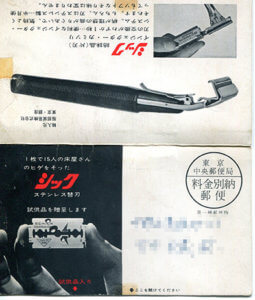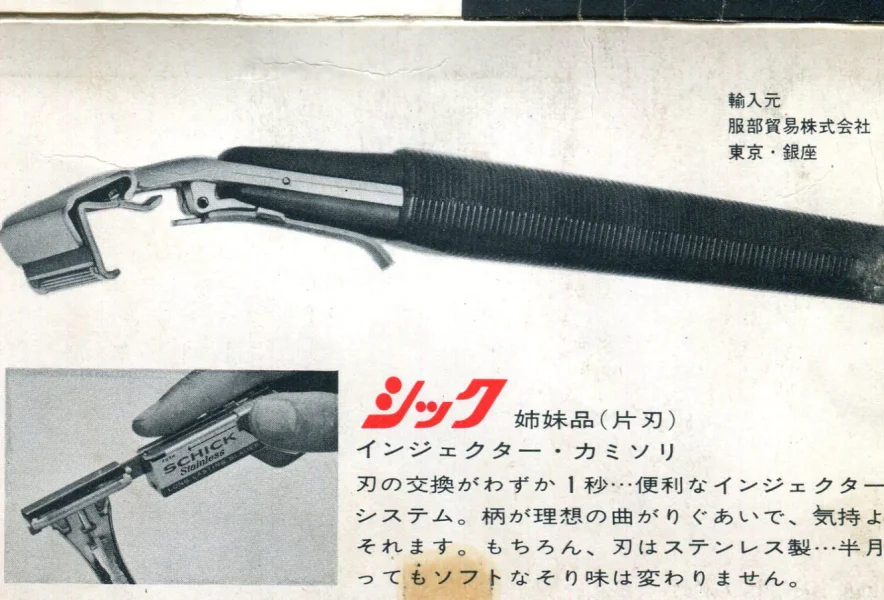Join Yasuoki Takeuchi, President of the Razor Club, for a look back at the Japanese wet shaving market and culture from the postwar period to 2025.
Schick conquered the Japanese market with its strategy.
Kanakura Takeuchi, the predecessor of the Razor Club, once said in an interview, “If the product is good, the advertising is good, and the sales network is good, it will sell. The key to success is how to recognize these factors. Behind the success of Chic, which started from absolutely nothing in the postwar era and went on to win the No. 1 position in the Japanese razor market, lies a simple marketing strategy that is relevant today and will be relevant in the future.

After giving up selling single-edged razors suitable for Japanese people because of the war, Kinzo came across a large poster in the razor section of a department store for foreigners, which showed “Chic’s” “Injector”. The visual of a little girl shaving her father’s beard was full of love and at the same time appealed to the safety of the injector. The “Injector” was a revolutionary product not only for its unique feel and sharpness, but also for its ability to be safely replaced without touching the blade. I remember experiencing it for the first time in a local barbershop when I was studying in the U.S., and thinking, “This is it. (Kanakura had a gut feeling that this was the way to go, and asked Eversharpsic directly to send him a sample.
However, at that time Sanpo Shoji (the predecessor of Razor Club) was a small company with about 20 employees. After the war, there were restrictions on foreign currencies, and imports had to be traded in dollars. In other words, it was difficult to buy from overseas unless the company had dollars for its own transactions. Therefore, Sanpo Shoji requested Hattori Watch & Clock Store (now Seiko Holdings), which had a track record of dollar transactions in watches, to act as an import agent, and Sanpo Shoji began handling the products as a sales contact in Japan.
At the time of import liberalization, Feathers held more than 80% of the domestic razor market, so trying hard in the same place wasn’t going to help.” Avoiding fighting on the same route, the company examines methods of recognition and image to establish the “chic” brand. The first challenge was to create opportunities for people to use single-edged razors anyway, as the majority of the market was dominated by double-edged razors.
In those days, imported goods from overseas had a very good image as ‘imported goods’ and were very popular. So we decided to sell them as high-end gifts at department stores first. If it was a gift, people would try it at least once.” While double-edged razors were the mainstream, the single-edged injector was displayed in a glass case in a department store for 600 yen (prices then were about 1/4 of today’s prices). It became a popular gift, attracting large orders for personalization on the holder. By popularizing the holder first, it contributed to the sales of replacement blades later on.
However, that era did not last long, and the center of consumption eventually shifted from department stores to mass merchandisers. In anticipation of the coming of the era of mass merchandisers, we shifted our sales structure to mass merchandisers nationwide at an early stage. I also checked out the sales floor and walked around the country visiting supermarkets to propose new sales pitches. I am glad that I was able to make use of my experience in the U.S., where I studied abroad, or rather “studied on a scholarship,” when I was a student.”

The razors, which had been sold face-to-face in showcases in cases, were converted to blister packs with a mount and clear plastic to accommodate self-service stores where customers could pick up the razor and take it to the cash register themselves. When we started getting direct business from them, it was right around the time ‘Super II’ was launched, and I still vividly remember how the new packaging looked on store shelves.” By entering the supermarket market early, the image of Chic’s “Injector” and the “stainless steel replacement blades” that we were focusing on at the same time quickly took hold, and we were able to shake off the market entry of “Gillette” and “Feather” or Lion and Kao. One of the reasons for this victory was the concentrated investment of funds in advertising, with an emphasis on TV commercials. Many of you may remember the impressive commercials for “Chic.
While thoroughly expanding awareness among general consumers, Sanpo Shoji also vigorously pursued local sales activities by expanding its sales offices to major cities throughout Japan. Eventually, razors entered the “double-blade” era, and “Gillette” sought to make a comeback in the Japanese market with the “G II” double-blade cartridge. However, the manufacturer (Warner-Lambert) made the wise decision to ship the S II product by air, and although it was late in its press release, it succeeded in making a strong impression on consumers by leading the nationwide sales in stores, thereby winning the double-blade duel.
Gillette is better capitalized and better able to develop products. Gillette is the leading company in terms of technology because we have patents. However, we were a trinity of manufacturer (Warner-Lambert), import agent (Hattori Seiko), and sales agent (Sanpo Shoji), connected by a strong pipeline.” Peter Oliver, the Far East manager of Ebersharp Chic, who was in possession of “Chic” at the time of the start of importation, clearly stated, “I will leave the sales of ‘Chic’ in Japan to the Japanese,” and this remained the case even after Ebersharp Chic merged with Warner-Lambert.

Kinzo Takeuchi had the same belief. I have a lot of respect for my father,” Takeuchi said, “because he was so thorough in implementing the idea that the Japanese market would be served by the Japanese. And I have no doubt that was a factor in his success.” The three companies meet regularly. The three companies met regularly and took measures with an overwhelming sense of ownership in promoting “chic” products.
Even today, when companies aim for the world market, they are faced with a choice: “global” or “local. More than 50 years ago, “Gillette” tried to integrate a global strategy for the Japanese razor market, and “Schick” tried to respect and adapt to the uniquely Japanese way. The major reason for the victory of “Schick” was the match in direction and sense of unity between “Schick” and Sanpo Shoji, who had a strong passion to make “Schick” the best in Japan with their own hands, riding on the momentum of the period of rapid economic growth.

